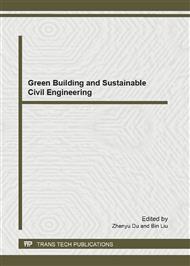[1]
2 Used for insulation outside The rigid polyurethane foam without solvent.
Google Scholar
[1]
2 Used for roofing heat preservation Roofing, outer wall, ground heat transfer coefficient K value calculation: F(roof)= 1/R R =δ/(λ·α) Rvalue calculation(refer with: Table 2) Table 2 : R value calculation Material material Coefficient of thermal conductivity (λ) Correction coefficient (α) Thick degree (δ) Thermal resistance (R) cement mortar hang watts.
DOI: 10.3403/01275705
Google Scholar
03 R=0. 03/0. 93=0. 032 the waterproof layer.
Google Scholar
004 R=0. 004/0. 17=0. 0235 cracking mortar.
Google Scholar
005 R=0. 005/0. 93=0. 0053 light mortar screed-coat.
Google Scholar
02 R=0. 02/0. 29=0. 0690 solvent free the rigid polyurethane foam.
Google Scholar
12 R=0. 12/ (1. 5X0. 027)=2. 963 cement mortar screed-coat.
Google Scholar
02 R=0. 02/0. 93=0. 02299 reinforced concrete roof board.
Google Scholar
1 R=0. 1/1. 74=0. 0575 mixed mortar.
Google Scholar
02 R=0. 02/0. 87=0. 023 ∑R(roof)=0. 032+0. 00235+0. 0053+0. 0690+2. 963+0. 02299+0. 0575+0. 023=3. 175 K(roof)=1/R=1/3. 175=0. 315 (W/(M2•K) F(roof)=107. 1㎡ Exterior wall K value calculation Main body wall(refer with: Table 3) Table 3: Main body wall Material material Coefficient of thermal conductivity (λ) Correction coefficient (α) Thick degree (δ) Thermal resistance (R) mixed mortar.
Google Scholar
02 R=0. 02/0. 87=0. 0230 the common clay bricks.
Google Scholar
37 R=0. 37/0. 81=0. 4570 the air layer.
Google Scholar
01 R=0. 140 polystyrene.
Google Scholar
08 R=0. 08/(0. 042x1. 2) =1. 361 the bond type powder polystyrene particles.
Google Scholar
[1]
2 10 R=0. 01 /(0. 070x1. 2)=0. 119 cracking mortar.
Google Scholar
005 R=0. 005/0. 93=0. 0053 ∑R =0. 0230+0. 4570+0. 14+1. 361+0. 119+0. 0053=2. 105 K (Main body wall )= 1/R=1/2. 105=0. 475 (W/(M2•K) F (Main body wall )=48. 888+46. 068*2+65. 688 =206. 712㎡ Ring beam, lintel, constructional column K value calculation(refer with: Table 4) Table 4: Ring beam, lintel, constructional column K value calculation Material material Coefficient of thermal conductivity (λ) Correction coefficient (α) Thick degree (δ) Thermal resistance (R) mixed mortar.
Google Scholar
02 R=0. 02/0. 87=0. 0230 Reinforced concrete column, beam.
Google Scholar
37 R=0. 37/1. 74=0. 2126 the air layer.
Google Scholar
01 R=0. 140 polystyrene.
Google Scholar
08 R=0. 08/(0. 042x1. 2) =1. 361 the bond type powder polystyrene particles.
Google Scholar
01 R=0. 01 /(0. 070x1. 2)=0. 119 cracking mortar.
Google Scholar
005 R=0. 005/0. 93=0. 0053 ∑R =0. 0230+0. 2126+0. 14+1. 361+0. 119+0. 0053=1. 861 K(bridge. column)= 1/R =1/1. 861=0. 537 (W/(M2•K) F(bridge. column)= (14. 28+7. 680)*2*0. 45=19. 764㎡ Exterior wall average heat transfer coefficient K(outer) = (K(main wall)x F(main wall)+ K(bridge. column)x F(bridge. column)/ (F(main wall)+ F(bridge. column)= (0. 475 x 206. 712+0. 537 x 19. 764)/206. 712+19. 764= (98. 1882+10. 61)/226. 476=0. 4834 (W/(㎡•K) The ground around the area of the house to take the around the area of the 2 m expansion after, so for: K(floor)= 0. 3 F(floor)= (2+14. 28+2)+ (2+7. 680+2)=18. 28*11. 68=213. 510㎡ Window wall area than calculation Open hole wall area calculation: F( south hole)= 1. 800*2. 000*3+1. 500*2. 000*2=16. 8 F (south)= (13. 800+0. 480)*4. 6-1. 800*2. 000*3-1. 500*2. 000*2=65. 688-10. 8-6=48. 888 Window wall area than: The south for: 16. 8/48. 888 = 0. 344 < 0. 35 North : 0 < 0. 25 East, west : 0 < 0. 30 Building material consumptions heat index: Heating period of indoor and outdoor temperature difference of the building(refer with: Table 5) ti=16 te= -6. 2 ti-te=22. 2 Table 5: Heating period of indoor and outdoor temperature difference of the building project Correction factor: E Ki [w/(m2. k)] Fi (m2) EKi . Fi (ti-te).E. Ki . Fi roof.
Google Scholar
[30]
025 666. 56 Exterior wall north.
Google Scholar
[17]
166 381. 086 east.
Google Scholar
[19]
056 423. 054 west.
Google Scholar
[19]
056 423. 054 south.
Google Scholar
[29]
384 652. 329 Outside door window north.
Google Scholar
[10]
5 233. 1 ground 1.
Google Scholar
[64]
053 1421. 976 Heating heat consumption (W) QH. T= (ti-te). ( ∑ E. Ki . Fi)=4201. 159 The air permeability of heat consumption (W) QINF= (ti-te). CP .N. V 0=22. 2 x0. 28 x1. 29 x0. 8 x585. 401=3755. 295 Heat transfer heat consumption index (W/m2) qH. T= QH. T/AO =4201. 159/112=37. 510 The air permeability of heat consumption index (W/m2) qINF= QINF/AO =3755. 295/112=33. 529 Internal heat qI. H=3. 8 Building material consumptions heat index (W/m2) qH= qH. T+ qINF- qI. H= 37. 510+33. 529-3. 8=67. 239 Conclusions According to the state formulates the standards for energy conservation Hohhot area: 21. 3, the residential building material consumptions heat index greater than 21. 3 67. 239, not the energy-saving standards. Advice is through the lower layer construction and increase condole top, to reduce the heat consumption index measures. Acknowledgements This work was financially supported by National Natural Science Foundation of China(50808099) and Inner Mongolia Natural Science Foundation of China (2010MS0709) and Inner Mongolia autonomous region higher school science research project of China(NJZY11155) and Inner Mongolia autonomous region higher school science research project of China (NJZY12114) and Inner Mongolia university of science and technology innovation fund project (2011NCL044). The authors would like to express our gratitudeto all those who helped us during the investigation process. Anonymous referees are gratefullyacknowledged for careful reviewing of the earlier version of this manuscript.
Google Scholar


